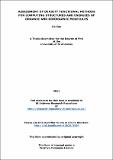Files in this item
Assessment of density functional methods for computing structures and energies of organic and bioorganic molecules
Item metadata
| dc.contributor.advisor | van Mourik, Tanja | |
| dc.contributor.author | Cao, Jie | |
| dc.coverage.spatial | 138 | en_US |
| dc.date.accessioned | 2012-05-08T15:32:30Z | |
| dc.date.available | 2012-05-08T15:32:30Z | |
| dc.date.issued | 2011-11-30 | |
| dc.identifier | uk.bl.ethos.552634 | |
| dc.identifier.uri | https://hdl.handle.net/10023/2589 | |
| dc.description.abstract | The work in this thesis mainly focuses on the assessment of density functional methods for computing structures and energies of organic and bioorganic molecules. Previous studies found dramatic conformational and stability changes from B3LYP to MP2 geometry optimization for some Tyr-Gly conformers. Possible reasons could be large intramolecular basis set superposition errors (BSSEs) in the MP2 calculations and the lack of dispersion in the B3LYP calculations. The fragmentation method and three kinds of rotation methods were used to investigate intramolecular BSSE. It is concluded that the rotation method cannot be used to correct intramolecular BSSE along a rotation profile. Another methodology is to employ modern density functionals. We focused on M06-L with the Tyr-Gly conformer ‘book6’. Potential energy profiles were determined by computing the energy for geometries optimized at various fixed values of a distance that controls the degree of foldedness of the structure. M06-L manifested itself as a very promising method to investigate the potential energy surface of small peptides containing aromatic residues. To predict Tyr-Gly structures, 108 potential conformers were created with a Fortran program. The geometry optimizations were done using M06-L/6-31G(d) and M05-2X/6-31+G(d). Two schemes were employed and the most stable conformers were compared to the 20 stable conformers found by B3LYP. Both schemes found 10 conformers similar to one of the B3LYP stable conformers, as well as several newly found conformers. The study of a missing B3LYP stable conformer showed that the possible reason of missing conformers may be the lack in dispersion in B3LYP theory. To study the hydration effect, we studied the conformations of neutral and zwitterionic 3-fluoro-γ-aminobutyric acid (3F-GABA) in solution using different solvation models, mainly the explicit water molecule models. Zwitterionic forms of 3F-GABA are preferred in solution. M06-2X performs better in calculating transition energy profiles than MP2. | en_US |
| dc.language.iso | en | en_US |
| dc.publisher | University of St Andrews | |
| dc.rights | Creative Commons Attribution-NonCommercial-NoDerivs 3.0 Unported | |
| dc.rights.uri | http://creativecommons.org/licenses/by-nc-nd/3.0/ | |
| dc.subject | Density functional | en_US |
| dc.subject | M06-L | en_US |
| dc.subject | Intramolecular BSSE | en_US |
| dc.subject | Tyr-Gly conformer | en_US |
| dc.subject | Transition energy profiles | en_US |
| dc.subject.lcc | QD462.6D45C2 | |
| dc.subject.lcsh | Density functionals | en_US |
| dc.title | Assessment of density functional methods for computing structures and energies of organic and bioorganic molecules | en_US |
| dc.type | Thesis | en_US |
| dc.type.qualificationlevel | Doctoral | en_US |
| dc.type.qualificationname | PhD Doctor of Philosophy | en_US |
| dc.publisher.institution | The University of St Andrews | en_US |
This item appears in the following Collection(s)
Except where otherwise noted within the work, this item's licence for re-use is described as Creative Commons Attribution-NonCommercial-NoDerivs 3.0 Unported
Items in the St Andrews Research Repository are protected by copyright, with all rights reserved, unless otherwise indicated.


